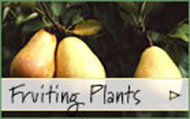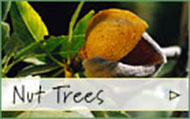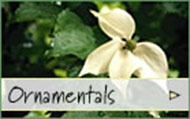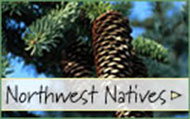NSNCOALA
|
|
 |
| ALASKA CEDAR (NOOTKA CYPRESS) (Callitropsis nootkatensis) |
| Northwest native conifer with a narrow form and downward sweeping branches. Yellow wood. Alaska Cedar is native on moist sites in the mountains of Oregon to Alaska. Can live 1500 years or more. Prefers moist soil. Prefers climates with cool summers. Large evergreen tree to about 35 ft. tall and 5 ft. wide. Also commonly called Nootka Cypress. Zone 5-9. |
|
|
NSNCOCOAST
|
|
 |
| COASTAL REDWOOD (Sequoia sempervirens) |
| They are one of the tallest living things on earth and are able to survive for over a thousand years. Native conifers to Pacific Coast forests and famously in Redwood National Park. Upright pyramidal form and can develop a buttress at the base. It does well on a damp acidic soil high in organic matter. Coastal Redwood is highly valued tree with rot resistant wood. Not as hardy as Giant Sequoia and it will do poorly in dry soil. Zone 7-8. |
|
|
NSNCODOU
|
|
 |
| DOUGLAS FIR (Pseudotsuga menziesii) |
| Fast growing native conifer that remains the most important commercial timber grown in the Pacific Northwest. Requires a sunny location. Douglas Fir is one of the tallest evergreens that is capable of growing over 200 ft. tall in its natural habitat, otherwise averaging 60-80 ft. Very long-lived tree that lives for several hundred years. Prefers moist soils and cool summers. Zone 4-6. |
|
|
NSNCOGIA
|
|
 |
| GIANT SEQUOIA (Sequoiadendron gigantium) |
| Fast growing, shade tolerant, and densely branched evergreen. Giant Sequoia is one of the tallest growing evergreens to heights of over 300 ft. and with massive trunk diameters. They are also capable of living for several thousand years. Wood is rot resistant. A California native that requires well-drained but moist soils high in organic matter. Especially healthy in foggy locations. The hardiest redwood, to about -15°F. Zone 6-8. |
|
|
NSNCOINC
|
|
 |
| INCENSE CEDAR (Calocedrus decurrens) |
| Very tall, narrow evergreen tree with dense foliage. Effective as a fast growing windbreak or privacy screen that can take shearing. Attractive to wildlife as a nesting site and for shelter. Incense Cedar has very aromatic foliage. Red scaly bark. Produces small cones. Native to the Pacific Northwest. Can grow 50-90 ft. with a spread of under 10 ft. wide. Zone 5-8. |
|
|
NSNCONOB
|
|
 |
| NOBLE FIR (Abies procera) |
| A beautiful, symmetrical evergreen native to the Pacific Northwest. Valued as an attractive ornamental landscape tree because of its short, stiff blue needles and large upright cones. Popular with birds and other wildlife that will eat its seeds and take shelter in its dense foliage. Nobel Fir can be used for cut boughs, lumber and is very popular as Christmas trees. Can grow over 200 ft. tall in its native habitat but more commonly 50-100 ft. Prefers moist, well-drained acidic soils. Zone 5-10. |
|
|
NSNCOPTO
|
|
 |
| PORT ORFORD CEDAR (Chamaecyparis lawsoniana) |
| Attractive evergreen with fragrant foliage and bark. Well suited for hedgerows because of its upright narrow form. Fast growing to an average height of 80 ft. but capable of up to 200 ft. in its native habitat. Native the Pacific Northwest, particularly to southern coastal Oregon. Port Orford Cedar is a popular landscape ornamental. Strong, rot resistant timber. Also known as Lawson Cypress. Zone 5-9. |
|
|
NSNCOSIT
|
|
 |
| SITKA SPRUCE (Picea sitchensis) |
| Important commercial timber evergreen tree in moist lowland and coastal sites of the Pacific Northwest. Fairly fast growth once established. Known to reach heights of 200-300 ft. or more in its natural habitat. Very long-lived with some trees living several hundred years. Sitka Spruce prefers coastal climate growing conditions. Bud worm resistant seed source. Also known as Tideland Spruce. Zone 7. |
|
|
NSNCORCED
|
|
 |
| WESTERN RED CEDAR (Thuja plicata) |
| Fast growing, very common native conifer in the Pacific Northwest. Will grow in shade and moist soils. Dark green scaly foliage is very aromatic. Red scaly bark. Grows to an average of 50-70 ft. tall but can reach up to 180 ft. in its native habitat. Long-lived. Rot resistant timber. All parts of Western Red Cedar can be used in crafts and woodworking. Hardy to -20° F. Zone 5-7. |
|
|

 Click here to view items for:
Winter / Spring (Jan-June)
Summer (July-Oct)
Fall (Nov-Dec)
Click here to view items for:
Winter / Spring (Jan-June)
Summer (July-Oct)
Fall (Nov-Dec)














